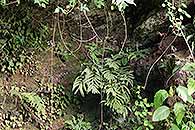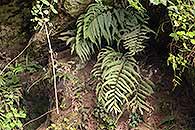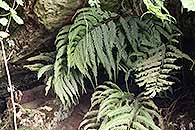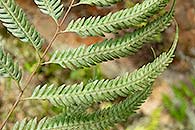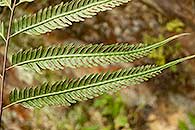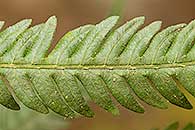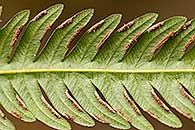Pteris kivuensis C.Chr.
Synonyms |
|
|---|---|
Common name |
|
Description |
Rhizome thick; rhizome scales linear-lanceolate in outline, apex long-pointed, chestnut coloured. Fronds Monomorphic, strongly herbaceous. Stipe to 50 cm long, at the base brown, with scales, upward shiny brown, bare, smooth and glabrous. Lamina subtripartite, broadly deltoid in outline, 35 cm or more long, gray-green, very glabrous, base bipinnate-pinnatifid, pinnate-pinnatifid above the basal pinnae; basal pinnae opposite, the central part of the lamina similar but smaller, ca. 20 cm long, petiole 3 cm long, stout, impari-pinnate; pinnules except terminal 3-jugate, ca. 12 x 2 cm, caudate-acuminate, base subsessile, abruptly wedged, pinnatifid 1-1.5 mm wide at the wing, subsequent pinnules 3-4 jugate, subopposite, 7-5 cm apart, ascending, basal pinnules similar, 15-18 x 3 cm; ultimate segments falcate, base decurrent, apex acute, margin toothed; costae straw-like, grooved above, bearing a spine 0.5 mm long at the base of the median nerve of the segments, below smooth, raised; veins straw-like, 10-12 jugate, most of them forked, with two basiscopic basal ones coming out of the costa, simple or forked. Sori set along the middle part of the lateral segments; indusia narrow, pale brown, entire. Translated from Latin, needs to be checked with specimens. |
Notes | Regarded as a synonym of H. usambarensis by some. P. kivuensis differs by a greyish green stipe, a lighter green lamina and less caudate pinna apices. |
Derivation | kivuensis: from Kivu; this fern was first collected by H. Humbert in the mountains west of Lake Kivu. |
Habitat | Forest, 2000-2400 m. |
Distribution worldwide | See African distribution. |
Distribution in Africa |
|
Growth form |
Terrestrial. |
Literature |
|
